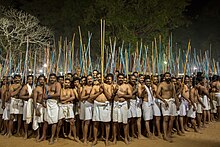| Revision as of 13:45, 14 November 2023 editBilgiljilll (talk | contribs)Extended confirmed users714 edits TypoTags: Visual edit Mobile edit Mobile web edit← Previous edit | Revision as of 13:45, 14 November 2023 edit undoBilgiljilll (talk | contribs)Extended confirmed users714 edits →Overview: Linked to toddyTags: Mobile edit Mobile web edit Disambiguation links addedNext edit → | ||
| Line 14: | Line 14: | ||
| Thira brings the gods to life. Performers dress up with ceremonial facial paint and loud clothing and dance in front of the deity, the bhagavathi. The objective clearly is to bring a sense of awe to the proceedings. Each performer represents a particular deity and is sponsored by devotees as a prayer offering. These dancers are viewed as being possessed by the gods when they are in their act, with devotees queuing up to meet them to share woes and wishes. | Thira brings the gods to life. Performers dress up with ceremonial facial paint and loud clothing and dance in front of the deity, the bhagavathi. The objective clearly is to bring a sense of awe to the proceedings. Each performer represents a particular deity and is sponsored by devotees as a prayer offering. These dancers are viewed as being possessed by the gods when they are in their act, with devotees queuing up to meet them to share woes and wishes. | ||
| Toddy plays a very significant role in the proceedings, it is an offering to the gods and almost all the performers dance under the influence. This helps in creating the feeling of being "possessed". The performers belong to the "Peruvannan" caste of , who are given prime importance in Thira . Therefore in Kerala, both Forward caste Brahmins, and backward caste and tribals have an important place in worship | ] plays a very significant role in the proceedings, it is an offering to the gods and almost all the performers dance under the influence. This helps in creating the feeling of being "possessed". The performers belong to the "Peruvannan" caste of , who are given prime importance in Thira . Therefore in Kerala, both Forward caste Brahmins, and backward caste and tribals have an important place in worship | ||
| ==References== | ==References== | ||
Revision as of 13:45, 14 November 2023
This article is about the ritual dance. For the records system, see THIRRA.| This article does not cite any sources. Please help improve this article by adding citations to reliable sources. Unsourced material may be challenged and removed. Find sources: "Thirra" – news · newspapers · books · scholar · JSTOR (December 2009) (Learn how and when to remove this message) |


Thirra or Theyyam thira is a ritual dance performed in "Kaavu"(grove) and temples of the Malabar region in Kerala State, South India. This art form is performed by the artists of malaya (the artist who recognised for performing the art form called as a "perumalayan") community. This art is performed during Utsavam (annual temple festival). Clan deities such as Bhagavathi, Shiva are worshipped in these forms.
Overview
Theyyam thira is main sub division of Theyyam. It is similar to the Theyyam dance performed in the same region, except that in Theyyam the performer is considered as the god he is representing, while in Thira the performer is considered as to be possessed by god.
Thira brings the gods to life. Performers dress up with ceremonial facial paint and loud clothing and dance in front of the deity, the bhagavathi. The objective clearly is to bring a sense of awe to the proceedings. Each performer represents a particular deity and is sponsored by devotees as a prayer offering. These dancers are viewed as being possessed by the gods when they are in their act, with devotees queuing up to meet them to share woes and wishes.
Toddy plays a very significant role in the proceedings, it is an offering to the gods and almost all the performers dance under the influence. This helps in creating the feeling of being "possessed". The performers belong to the "Peruvannan" caste of , who are given prime importance in Thira . Therefore in Kerala, both Forward caste Brahmins, and backward caste and tribals have an important place in worship
References
External links
| Capital: Thiruvananthapuram | |||||||
| Districts | |||||||
| Topics | |||||||
| Symbols |
| ||||||
| Taluks |
| ||||||
| Municipal corporations | |||||||
| Municipalities |
| ||||||
| Other towns |
| ||||||
| Historical regions | |||||||